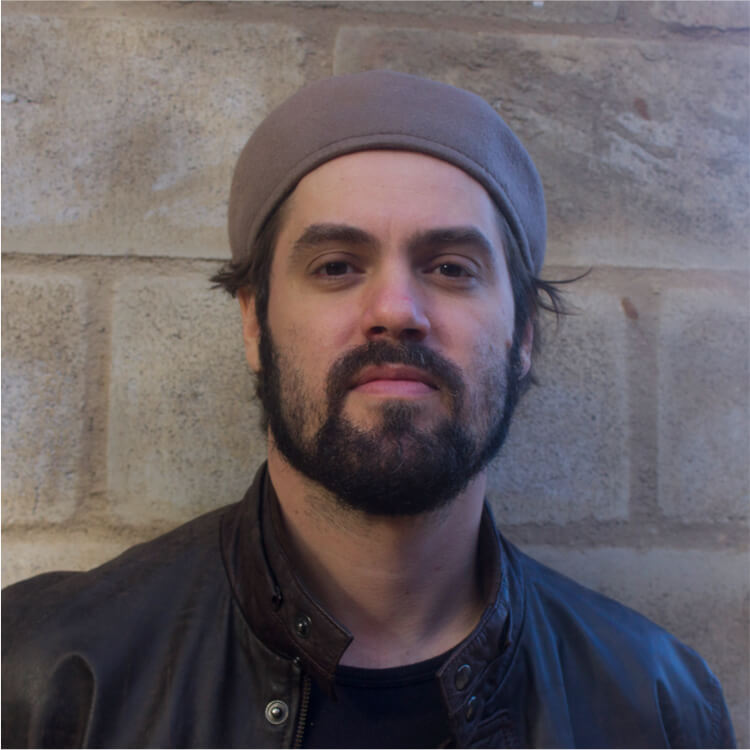Gabriel Scapinelli
and Otávio Monteiro


Gabriel Scapinelli was born in São Paulo in 1983. In 2003, he moved to Florianópolis in the Southern state of Santa Catarina. He graduated in Architecture and Urbanism from Universidade Federal de Santa Catarina and in Visual Arts from Universidade do Estado de Santa Catarina.
In the coastal city, he worked on two projects: xilocoletivo, a carpentry initiative led by a group of architects, and grupo fora, aimed at producing art in public spaces. His works from this period intertwine the two projects, such as the exhibition Bichos Bancos (FUNARTE ATOS VISUAIS, 2013), a combination of artistic carpentry and an art studio devoted to the transformation of the space.
In 2016, Scapinelli relocated to Belo Horizonte, where he obtained his Masters’ Degree from the School of Architecture and Design (EAD) at Universidade Federal de Minas Gerais. His research was a homage to Gilberto Gil’s song Refazenda, a composition of narrative landscapes that introduce eco-sophical thoughts and include terrarios, works produced by grupo fora, which featured in the exhibition Art for a Sensitive City, at Museu Mineiro in 2017.
In 2018, he resumed his work as a carpenter in Campinas, in the state of São Paulo, where he founded Tavolino, an artisanal carpentry studio. He also worked sporadically as a gardening teacher at a primary and secondary school (Escola Maré) in Cotia, also in the state of São Paulo, and as an artist, taking part in exhibitions and other initiatives, including Jardinalidades (SESC Dom Pedro, 2019) and Onde estão os outros (Subsolo espaço de arte, 2019).
The artist is currently investigating processes of collective engagement through the knowledge of making, art as a space of social transformation and social sculptures. His latest project [terra>tijolo=forno]+farinha*pão [[earth>brick=oven]+flour*bread] was selected by the 10th edition of Mostra 3M de Arte, where he will lead a one-month baking studio in Ibirapuera Park, São Paulo.
—
Otávio Arcanjo Monteiro. Born in 1992, Poços de Caldas, Minas Gerais. Lives and works in Campinas, São Paulo. He graduated in Design from Universidade Federal de Minas Gerais (UFMG) in 2017 and from Cambridge School of Art in 2014/15. He is currently pursuing a Masters’ Degree in Architecture, Technology and the City at Universidade Estadual de Campinas (UNICAMP). His practice lies in the intersection between art, architecture and design, as a proposition to increase these disciplines’ imaginative ability through public and collaborative projects. In 2019, his Mimeógrafo: Ep.01 [Mimeograph: Ep.01] – a work produced in collaboration with Gabriel Scapinelli – featured in Reproduções [Reproductions] at Pavão, in Campinas. He also created the public installation BANCA, in Belo Horizonte, in 2016/18. In 2017, he worked as art producer at Palácio das Artes, in Belo Horizonte. In 2016, his exhibition Livro expandido: espaço público [Expanded Book: Public Space] – created in partnership with Vinícius Arcanjo – was hosted by Paço das Águas, in Poços de Caldas. In the same year, he took part in the collective show Conexões imprevistas: 4e25 Editora Piolho Nababo [Unpredictable Connections] at SESC Palladium, Belo Horizonte. He also co-edited artists’ books at Editora, in Belo Horizonte (2016), and At Press, in Cambridge (2015). Also in 2015, he created the installation Outside at Ruskin Gallery, Cambridge, for which he received the Sustainability Art Prize, promoted by the gallery. As an art educator, he coordinated the project Decentralizing Access at Instituto Inhotim, in Brumadinho, in 2012/14.
—
Gabriel Scapinelli and Otávio Arcanjo’s propose to construct imagery through a public and collective project. Developed specifically for this show, the project consists of a communal oven: a social sculpture that activates relationships between individuals and presents an open, unresolved social-environmental equation, which can only be solved by multiple hands, collectively. The idea is to create a common space dedicated to encounters and a common interest in the constant search for connections between art and shared resistance, between sensate knowledge and everyday life. The poetics of making as an extraordinarily delicate act in these heavy times.

